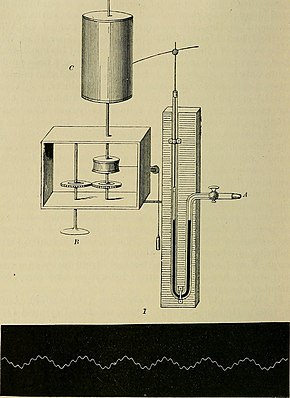Kymograph: Difference between revisions
Rescuing 1 sources and tagging 0 as dead.) #IABot (v2.0 |
Citation bot (talk | contribs) Alter: isbn. Removed URL that duplicated unique identifier. Removed parameters. | You can use this bot yourself. Report bugs here. | Activated by User:AManWithNoPlan | All pages linked from User:AManWithNoPlan/sandbox2 | via #UCB_webform_linked |
||
| Line 11: | Line 11: | ||
A '''kymograph''' (from Greek |
A '''kymograph''' (from Greek |
||
The kymograph was initially a mechanical and hydraulic device, invented by German [[physiologist]] [[Carl Ludwig]] in the 1840s, and found its first use as a means to monitor [[blood pressure]]. The blood pressure was conveyed by hydraulics and levers to move a stylus that scratched a white trace into soot-covered paper on the revolving drum. Time is represented by the drum's rotation rate, and was recorded by a further stylus driven by a clock or tuning fork. The kymograph almost immediately became the central instrument in physiology and physiology education. Throughout the nineteenth and twentieth centuries, researchers and technicians devised many improvements to the device, plus numerous new sensory components to measure a wide range of physiological phenomena such as breathing, muscle movement, speech. New detection and registration systems included electrical and electronic methods, and plotted in ink.<ref>{{Cite journal|last=Kwan|first=Alistair |
The kymograph was initially a mechanical and hydraulic device, invented by German [[physiologist]] [[Carl Ludwig]] in the 1840s, and found its first use as a means to monitor [[blood pressure]]. The blood pressure was conveyed by hydraulics and levers to move a stylus that scratched a white trace into soot-covered paper on the revolving drum. Time is represented by the drum's rotation rate, and was recorded by a further stylus driven by a clock or tuning fork. The kymograph almost immediately became the central instrument in physiology and physiology education. Throughout the nineteenth and twentieth centuries, researchers and technicians devised many improvements to the device, plus numerous new sensory components to measure a wide range of physiological phenomena such as breathing, muscle movement, speech. New detection and registration systems included electrical and electronic methods, and plotted in ink.<ref>{{Cite journal|last=Kwan|first=Alistair|title="Do not kill guinea pig before setting up apparatus": the kymograph's lost educational context|year= 2016 |url=http://teorievedy.flu.cas.cz/index.php/tv/article/view/345|journal=Teorie Vědy|volume=38|pages=301–335}}</ref> |
||
Kymographs were also used outside medical science to measure atmospheric pressure, tuning fork vibrations, the functioning of steam engines, animal habits and the movement of molecules in cells. |
Kymographs were also used outside medical science to measure atmospheric pressure, tuning fork vibrations, the functioning of steam engines, animal habits and the movement of molecules in cells. |
||
== Kymography in experimental Physiology == |
== Kymography in experimental Physiology == |
||
Kymograph is generally used to study the effects of [[xenobiotics]] on tissue preparations. It is a standalone recording apparatus used alongside other apparatus such as organ bath. Writing levers are used to trace the recording from muscle contractions. Some of the commonly used writing levers are simple lever, frontal writing lever and starling heart lever to name a few. These writing levers are connected to a [[wikt:fulcrum|fulcrum]] which are found on secondary apparatus.<ref>{{Cite book |
Kymograph is generally used to study the effects of [[xenobiotics]] on tissue preparations. It is a standalone recording apparatus used alongside other apparatus such as organ bath. Writing levers are used to trace the recording from muscle contractions. Some of the commonly used writing levers are simple lever, frontal writing lever and starling heart lever to name a few. These writing levers are connected to a [[wikt:fulcrum|fulcrum]] which are found on secondary apparatus.<ref>{{Cite book|title=Fundamentals of experimental pharmacology|last= M.N. Ghosh; J.R. Vedasiromoni|year=2015 |isbn=978-8190296502|edition= Sixth |location=Kolkata|oclc=949350586}}</ref> |
||
==See also== |
==See also== |
||
Revision as of 18:07, 31 March 2020
| Kymograph | |
|---|---|
 Ludwigs kymograph. One limb of the manometer is connected to a stylus which writes on the kymograph. Below: kymograph recording
ICD10 = | |
| MeSH | D007734 |
A kymograph (from Greek
The kymograph was initially a mechanical and hydraulic device, invented by German physiologist Carl Ludwig in the 1840s, and found its first use as a means to monitor blood pressure. The blood pressure was conveyed by hydraulics and levers to move a stylus that scratched a white trace into soot-covered paper on the revolving drum. Time is represented by the drum's rotation rate, and was recorded by a further stylus driven by a clock or tuning fork. The kymograph almost immediately became the central instrument in physiology and physiology education. Throughout the nineteenth and twentieth centuries, researchers and technicians devised many improvements to the device, plus numerous new sensory components to measure a wide range of physiological phenomena such as breathing, muscle movement, speech. New detection and registration systems included electrical and electronic methods, and plotted in ink.[3]
Kymographs were also used outside medical science to measure atmospheric pressure, tuning fork vibrations, the functioning of steam engines, animal habits and the movement of molecules in cells.
Kymography in experimental Physiology
Kymograph is generally used to study the effects of xenobiotics on tissue preparations. It is a standalone recording apparatus used alongside other apparatus such as organ bath. Writing levers are used to trace the recording from muscle contractions. Some of the commonly used writing levers are simple lever, frontal writing lever and starling heart lever to name a few. These writing levers are connected to a fulcrum which are found on secondary apparatus.[4]
See also
References
- ^ University of Toronto Scientific Instruments Collection. "Vertical Kymograph". www.psych.utoronto.ca. Archived from the original on 2008-12-11. Retrieved 2017-04-29.
- ^ Science Museum. "Kymograph, London, England, 1925-1935".
- ^ Kwan, Alistair (2016). ""Do not kill guinea pig before setting up apparatus": the kymograph's lost educational context". Teorie Vědy. 38: 301–335.
- ^ M.N. Ghosh; J.R. Vedasiromoni (2015). Fundamentals of experimental pharmacology (Sixth ed.). Kolkata. ISBN 978-8190296502. OCLC 949350586.
{{cite book}}: CS1 maint: location missing publisher (link) CS1 maint: multiple names: authors list (link)
